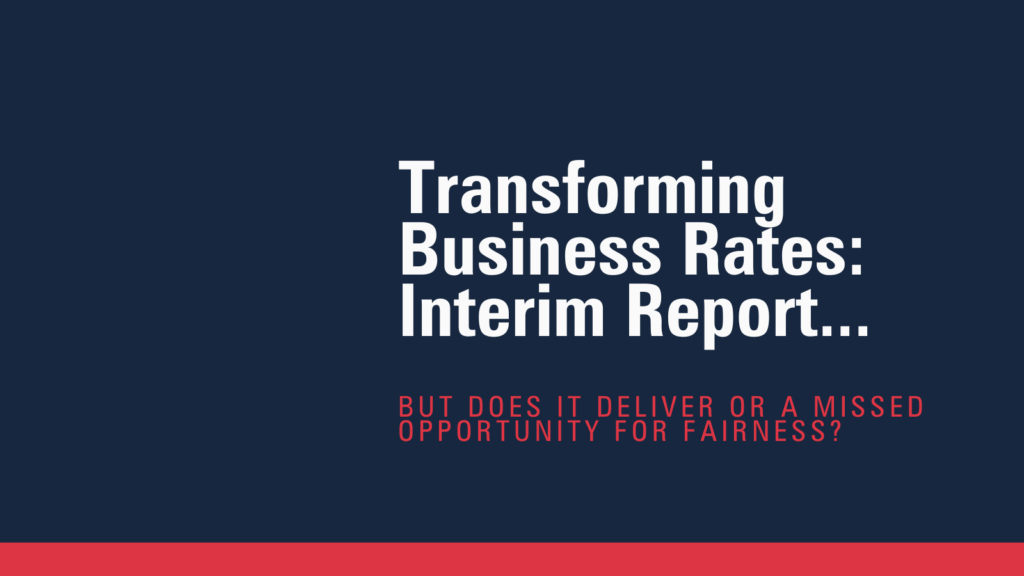The government claims its newly published Transforming Business Rates: Interim Report is designed to support business growth. It has received a lukewarm reception from the real estate, retail and hospitality industries.
Tim Ford, a director in the professional services team at Innes England, scrutinises the key proposals:
Proposal 1: ‘Slab’ to ‘slice’ reform – a move from the current system, where a single multiplier is paid on the full rateable value of a property, to a new structure based on marginal tax rates, with successive bands taxed at increasing rates.
Tim: This will mean that the higher the rateable value is banded, the higher the rate of tax. This seems to unfairly penalise larger businesses. I don’t see the logic: the rate should be fixed across all rateable properties. Whilst this proposal will smooth the transition between bands this alteration will increase the uncertainty of calculating rates liability, making an already complicated system even more complex. It could result in occupiers such as Amazon paying nothing on the first £12,000 of a £1,000,000 assessment.
Proposal 2: Enhancing Small Business Rates Relief (SBRR), to support business growth and investment
Tim: No one can argue with this. Small businesses are struggling with rent and salary costs, so any reduction or relief from business rates – generally the third highest cost for businesses – should be welcomed. Currently, if a business takes a larger property or multiple properties it can lose SBRR. This is counter intuitive and an obvious disincentive to growth.
I would suggest that banding for the relief should also be increased, making more businesses eligible to receive it.
Proposal 3: Addressing concerns over the ‘Receipts & Expenditure’ methodology
Tim: The R&E basis of valuation relates to trade related businesses, for example public houses, which are unquestionably struggling across the country. Whilst it might seem sensible that the more profitable a business is the more tax it should pay, business rates are based on the property in occupation, not business performance, which is subject to other taxes. Again – the whole system needs a complete overhaul.
Proposal 4: Exploring the possible benefits of shortening the Antecedent Valuation Date in the future
Tim: The AVD is the date used to benchmark property values for a revaluation. At the moment it is set two years ahead of the revaluation so values can be out of touch with market reality on day one of a revaluation and can be five years out of date by the end. Reducing the delay between AVD and revaluation would increase the fairness of the system and should be possible if the VOA is properly resourced. Shelving this proposal is a missed opportunity to make the system fairer and more responsive.
The government has also stepped away from more frequent re-assessments, which may have advantages, but would add uncertainty for all businesses trying to budget over more than 2-3 years. The current system is an incredibly inefficient process with many rates challenges taking years to be resolved. If the process takes longer than the period between AVDs, then businesses may be left in perpetual uncertainty, forever wondering what their rates liability might actually be.
Proposal 5: Using the merger of the Valuation Office Agency with HMRC to pursue administrative changes that help ratepayers
Tim: One would hope that the system/process couldn’t get any worse!
The one that got away: Empty Property Relief
Tim: The elephant in the room, EPR adds risk and uncertainty to potential investments, forcing landlords to pay tax when they have no income. Rather than reform, the government seems to be advocating a crackdown on the abuse of empty property relief. There is a development viability crisis: EPR isn’t helping and the latest proposals fail to acknowledge this.
Conclusion
Tim: The government claims the Interim Report provides “a blueprint to reform business rates to incentivise investment.” I’m not wholly convinced: the proposals do nothing to address the fundamental concern from business, which is that the tax rate has increased under successive governments from 34.8% to 55.5% since 1990 and that the business community has been treated as a cash cow for the Treasury.
The proposals have yet to be greenlit – that will be down to the Autumn Budget. In the meantime, the real estate industry must continue to lobby for meaningful relief and reform to the business rates regime.


